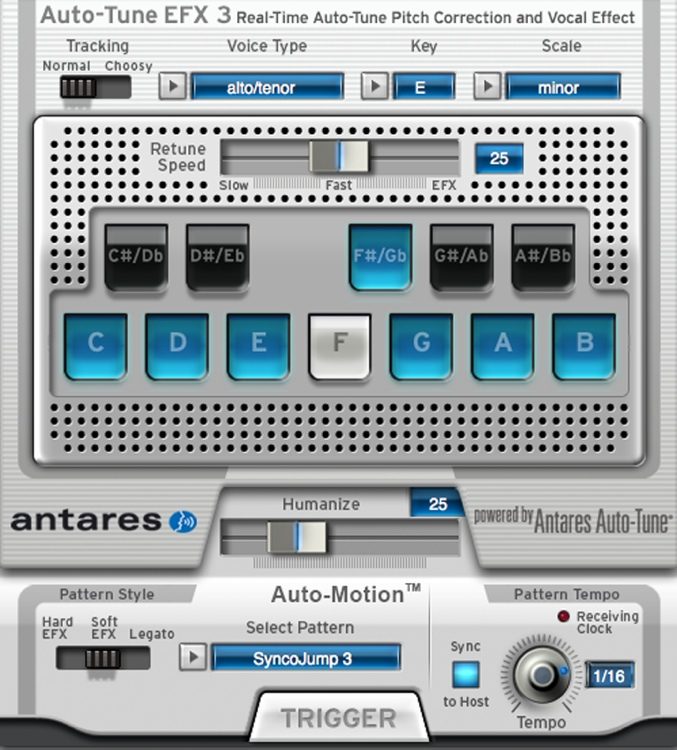Free Antares Auto Tune Efx Rtas Crack Free And Software

1: One of the improvements in Auto-Tune 4 is the Virtual Keyboard, which shows the currently detected pitch (blue key), scale notes (white and black keys), bypassed notes (brown keys), and removed notes (gray keys). Scale notes can also be input from the keyboard. Auto-Tune 4 is the most powerful, flexible, and user-friendly version yet of Antares's popular pitch-correction plug-in. It offers numerous new tools and functions, an improved ergonomic layout, and support for sampling rates up to 192 kHz.
Thank you for using our software library. Use the link given below and proceed to the developer's website in order to download Auto-Tune EFX RTAS free. 1000 most important words norman schur pdf files in windows 10. We wish to warn you that since Auto-Tune EFX RTAS files are downloaded from an external source, FDM Lib bears no responsibility for the safety of such downloads.
It runs as a VST, MAS, RTAS, and TDM plug-in on the Mac, and as a DirectX or RTAS plug-in in Windows. (According to Antares, a TDM version of Auto-Tune for XP should be released by the time this review is printed.) I reviewed version 4.1.2 in MAS format under Mac OS 10.2.8 and OS 9 (running Digital Performer 4.12 and 3.02, respectively), using a dual 867 MHz G4 loaded with 1.8 GB of RAM. Installation was straightforward, and authorization used the challenge-and-response method. AUTOMATIC IMPROVEMENTS Many of Auto-Tune 4's improvements consist of refinements and helpful additions to existing features. For instance, in Auto-Tune 3 you can define scales by playing them on a MIDI controller while using the Learn Scale From MIDI function.
Alternatively, you can target specific pitches on the fly by playing a MIDI controller in real time while using the Target Notes Via MIDI function. But these features, which are also in version 4, are inaccessible to users who lack a MIDI controller or who have DAWs that can't send MIDI data to plug-ins.
Auto-Tune 4 adds a virtual keyboard (see Fig. 1), which can be played with a mouse in Automatic mode to define target notes for correction. The virtual keyboard spans the plug-in's pitch-detection range. Its black-and-white keys turn blue to indicate the pitch of the audio as it plays, providing useful visual feedback. If you click and hold your mouse on the Hold button (located just below the pitch-change indicator), the blue detected-pitch indication on the virtual keyboard will freeze along with the display on the pitch-change indicator. The latter indication can be especially useful for determining how far out of tune fast-passing notes are, and the intensity of Auto-Tune 4's corrective action.
In older versions of Auto-Tune, you removed or added scale notes using the Edit Scale display. Although that feature has been retained, Auto-Tune 4 lets you accomplish the same thing by clicking on individual keys on the virtual keyboard.
The newer method allows you to edit the Remove and Bypass status of target notes of the same name but that are in different octaves. (Removing a note takes it completely out of a scale so that any input note on or close to it would be corrected to the nearest remaining scale note. Bypassing a note allows pitches on or close to it to remain unaffected.). 2: Auto-Tune 4's Graphical mode includes useful new tools for the Pitch graph and the Envelope graph, and a better-organized layout of navigation controls. This octave-specific treatment of notes is now available when using Auto-Tune 4's MIDI-input functions.

While using the Learn Scale From MIDI or Target Notes Via MIDI functions, you can click on the Octaves As Played button to determine target-note behavior in specific octaves, or the All Octaves button to do the same throughout Auto-Tune 4's usable range. Both Momentary and Latching modes are available when clicking on the virtual keyboard with a mouse. Latching mode toggles the Remove or Bypass status of a note each time you click its corresponding key. Momentary mode, on the other hand, changes the Remove or Bypass status of a note for only as long as you click and hold the mouse on its corresponding key, providing an easy way to treat isolated notes on the fly while leaving the pitch-correction setup for the rest of the phrase or track intact. The virtual keyboard is active only for major, minor, and chromatic scales, but that covers most popular-music applications. Auto-Tune 4 has useful new scale-editing shortcuts to supplement the Set Major Scale and Set Minor Scale functions. The Set All button deletes all current Remove and Bypass settings to return an edited scale to its default state.